park assist Lexus ES350 2020 Owner's Manual / LEXUS 2020 ES350 FROM OCT. 2019 PROD. OWNER'S MANUAL (OM06194U)
[x] Cancel search | Manufacturer: LEXUS, Model Year: 2020, Model line: ES350, Model: Lexus ES350 2020Pages: 450, PDF Size: 9.81 MB
Page 3 of 450
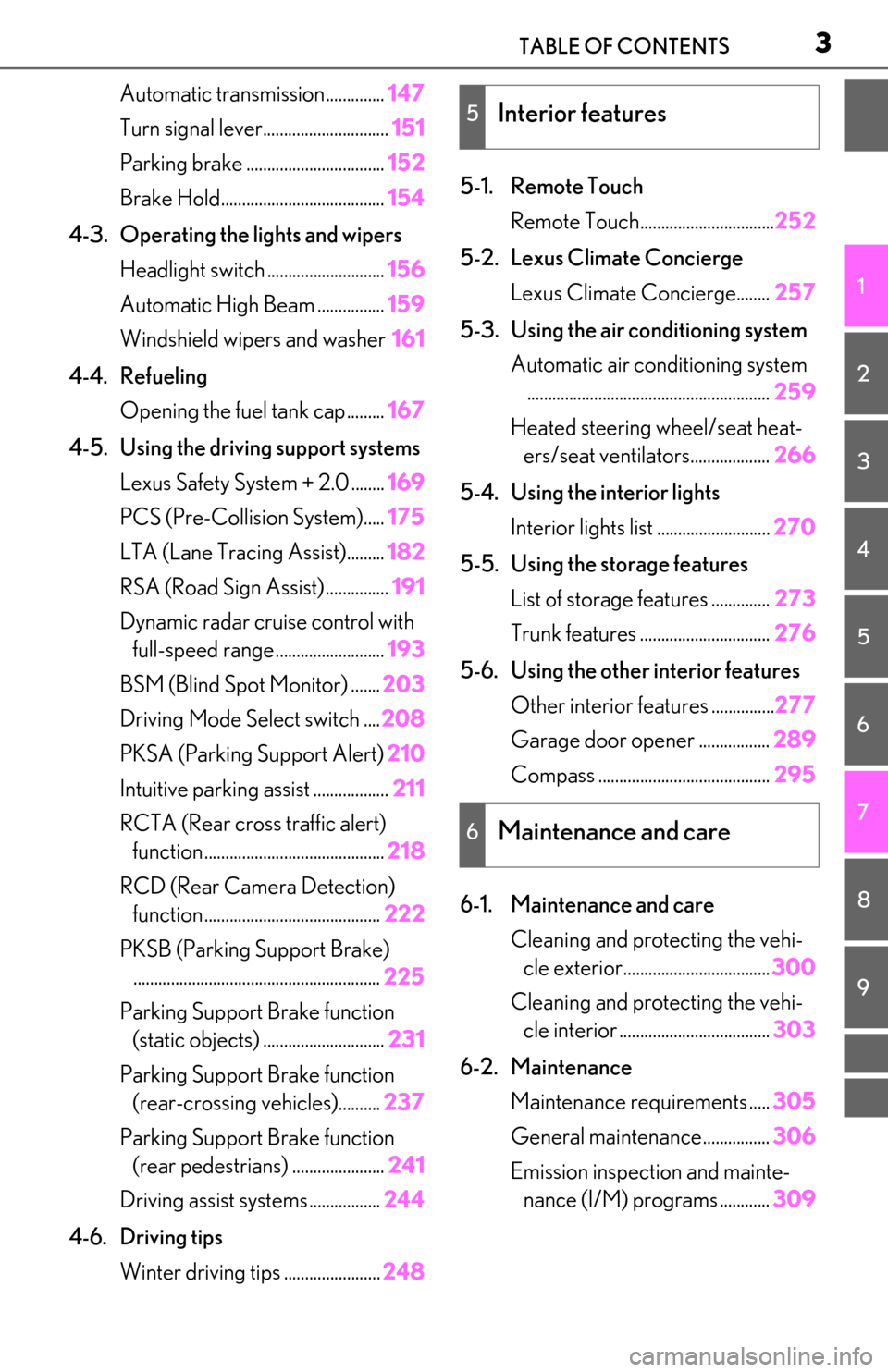
3TABLE OF CONTENTS
1
2
3
4
5
6
7
8
9
Automatic transmission..............147
Turn signal lever.............................. 151
Parking brake ................................. 152
Brake Hold....................................... 154
4-3. Operating the lights and wipers Headlight switch ............................ 156
Automatic High Beam ................ 159
Windshield wipers and washer 161
4-4. Refueling Opening the fuel tank cap......... 167
4-5. Using the driving support systems Lexus Safety System + 2.0 ........ 169
PCS (Pre-Collision System)..... 175
LTA (Lane Tracing Assist)......... 182
RSA (Road Sign Assist) ............... 191
Dynamic radar crui se control with
full-speed range.......................... 193
BSM (Blind Spot Monitor) ....... 203
Driving Mode Select switch .... 208
PKSA (Parking Support Alert) 210
Intuitive parking assist .................. 211
RCTA (Rear cross traffic alert) function ........................................... 218
RCD (Rear Camera Detection) function .......................................... 222
PKSB (Parking Support Brake) ........................................................... 225
Parking Support Brake function (static objects) ............................. 231
Parking Support Brake function (rear-crossing vehicles).......... 237
Parking Support Brake function (rear pedestrians) ...................... 241
Driving assist systems ................. 244
4-6. Driving tips Winter driving tips ....................... 2485-1. Remote Touch
Remote Touch................................ 252
5-2. Lexus Climate Concierge Lexus Climate Concierge........ 257
5-3. Using the air conditioning system Automatic air conditioning system.......................................................... 259
Heated steering wheel/seat heat- ers/seat ventilators................... 266
5-4. Using the interior lights Interior lights list ........................... 270
5-5. Using the storage features List of storage features .............. 273
Trunk features ............................... 276
5-6. Using the other interior features Other interior features ............... 277
Garage door opener ................. 289
Compass ......................................... 295
6-1. Maintenance and care Cleaning and protecting the vehi-cle exterior................................... 300
Cleaning and protecting the vehi- cle interior .................................... 303
6-2. Maintenance Maintenance re quirements .....305
General maintenance
................ 306
Emission inspection and mainte- nance (I/M) programs ............ 309
5Interior features
6Maintenance and care
Page 69 of 450
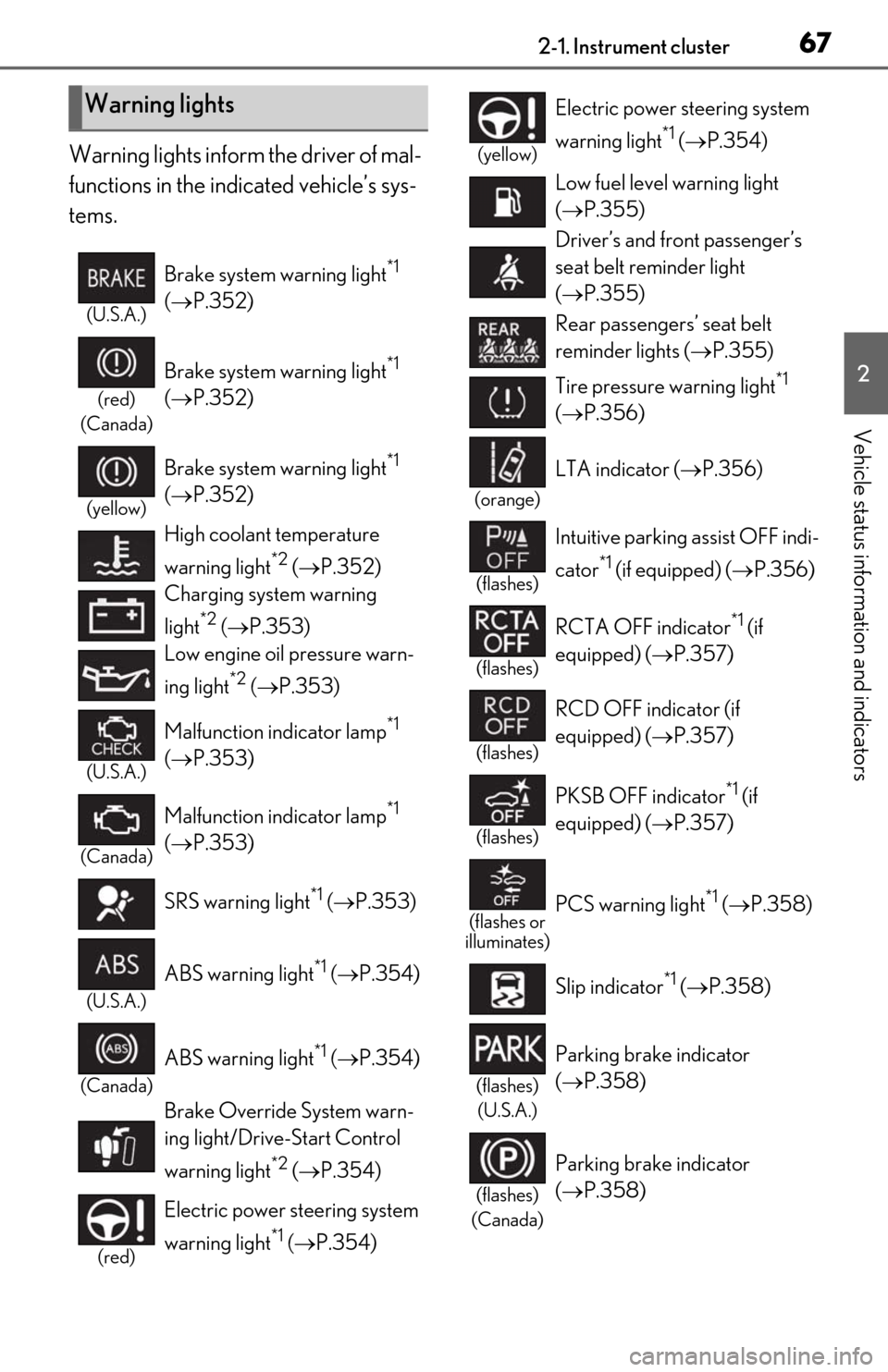
672-1. Instrument cluster
2
Vehicle status information and indicators
Warning lights inform the driver of mal-
functions in the indicated vehicle’s sys-
tems.
Warning lights
(U.S.A.)
Brake system warning light*1
( P.352)
(red)
(Canada)
Brake system warning light*1
( P.352)
(yellow)
Brake system warning light*1
( P.352)
High coolant temperature
warning light
*2 ( P.352)
Charging system warning
light
*2 ( P.353)
Low engine oil pressure warn-
ing light
*2 ( P.353)
(U.S.A.)
Malfunction indicator lamp*1
( P.353)
(Canada)
Malfunction indicator lamp*1
( P.353)
SRS warning light
*1 ( P.353)
(U.S.A.)
ABS warning light*1 ( P.354)
(Canada)
ABS warning light*1 ( P.354)
Brake Override System warn-
ing light/Drive-Start Control
warning light
*2 ( P.354)
(red)
Electric power st eering system
warning light
*1 ( P.354)
(yellow)
Electric power steering system
warning light
*1 ( P.354)
Low fuel level warning light
( P.355)
Driver’s and front passenger’s
seat belt re minder light
( P.355)
Rear passengers’ seat belt
reminder lights ( P.355)
Tire pressure warning light
*1
( P.356)
(orange)
LTA indicator ( P.356)
(flashes)
Intuitive parking assist OFF indi-
cator
*1 (if equipped) (P.356)
(flashes)
RCTA OFF indicator*1 (if
equipped) ( P.357)
(flashes)
RCD OFF indicator (if
equipped) (P.357)
(flashes)
PKSB OFF indicator*1 (if
equipped) ( P.357)
(flashes or
illuminates)PCS warning light*1 ( P.358)
Slip indicator
*1 ( P.358)
(flashes)
(U.S.A.)
Parking brake indicator
( P.358)
(flashes)
(Canada)
Parking brake indicator
( P.358)
Page 70 of 450
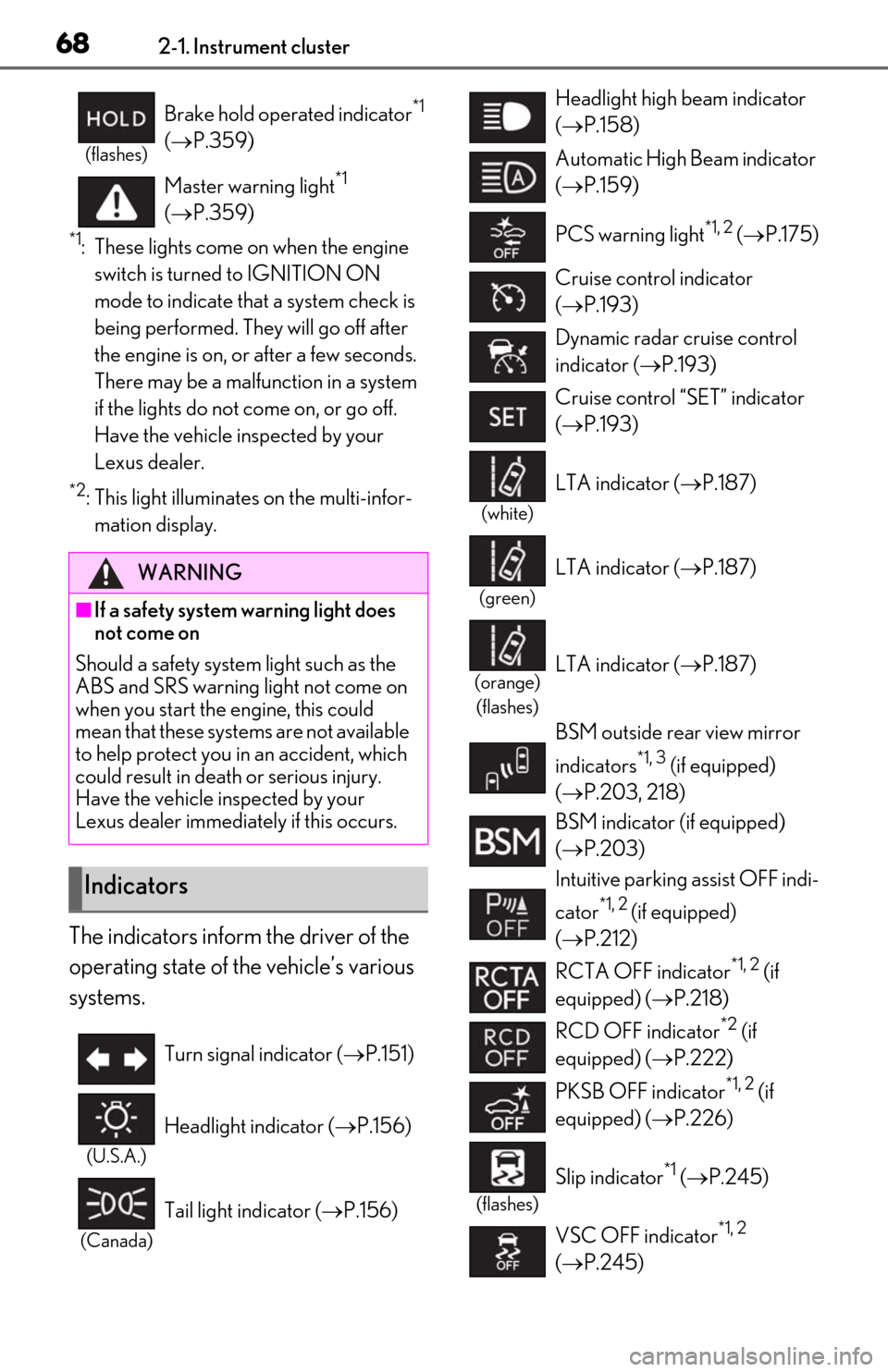
682-1. Instrument cluster
*1: These lights come on when the engine switch is turned to IGNITION ON
mode to indicate that a system check is
being performed. They will go off after
the engine is on, or after a few seconds.
There may be a malfunction in a system
if the lights do not come on, or go off.
Have the vehicle inspected by your
Lexus dealer.
*2: This light illuminates on the multi-infor- mation display.
The indicators inform the driver of the
operating state of the vehicle’s various
systems.
(flashes)
Brake hold operated indicator*1
( P.359)
Master warning light
*1
( P.359)
WARNING
■If a safety system warning light does
not come on
Should a safety system light such as the
ABS and SRS warning light not come on
when you start the engine, this could
mean that these systems are not available
to help protect you in an accident, which
could result in death or serious injury.
Have the vehicle inspected by your
Lexus dealer immediately if this occurs.
Indicators
Turn signal indicator ( P.151)
(U.S.A.)
Headlight indicator ( P.156)
(Canada)
Tail light indicator ( P.156)
Headlight high beam indicator
( P.158)
Automatic High Beam indicator
( P.159)
PCS warning light
*1, 2 ( P.175)
Cruise control indicator
( P.193)
Dynamic radar cruise control
indicator ( P.193)
Cruise control “SET” indicator
( P.193)
(white)
LTA indicator ( P.187)
(green)
LTA indicator (P.187)
(orange)
(flashes)LTA indicator ( P.187)
BSM outside rear view mirror
indicators
*1, 3 (if equipped)
( P.203, 218)
BSM indicator (if equipped)
( P.203)
Intuitive parking assist OFF indi-
cator
*1, 2 (if equipped)
( P.212)
RCTA OFF indicator
*1, 2 (if
equipped) ( P.218)
RCD OFF indicator
*2 (if
equipped) ( P.222)
PKSB OFF indicator
*1, 2 (if
equipped) ( P.226)
(flashes)
Slip indicator*1 ( P.245)
VSC OFF indicator
*1, 2
( P.245)
Page 84 of 450
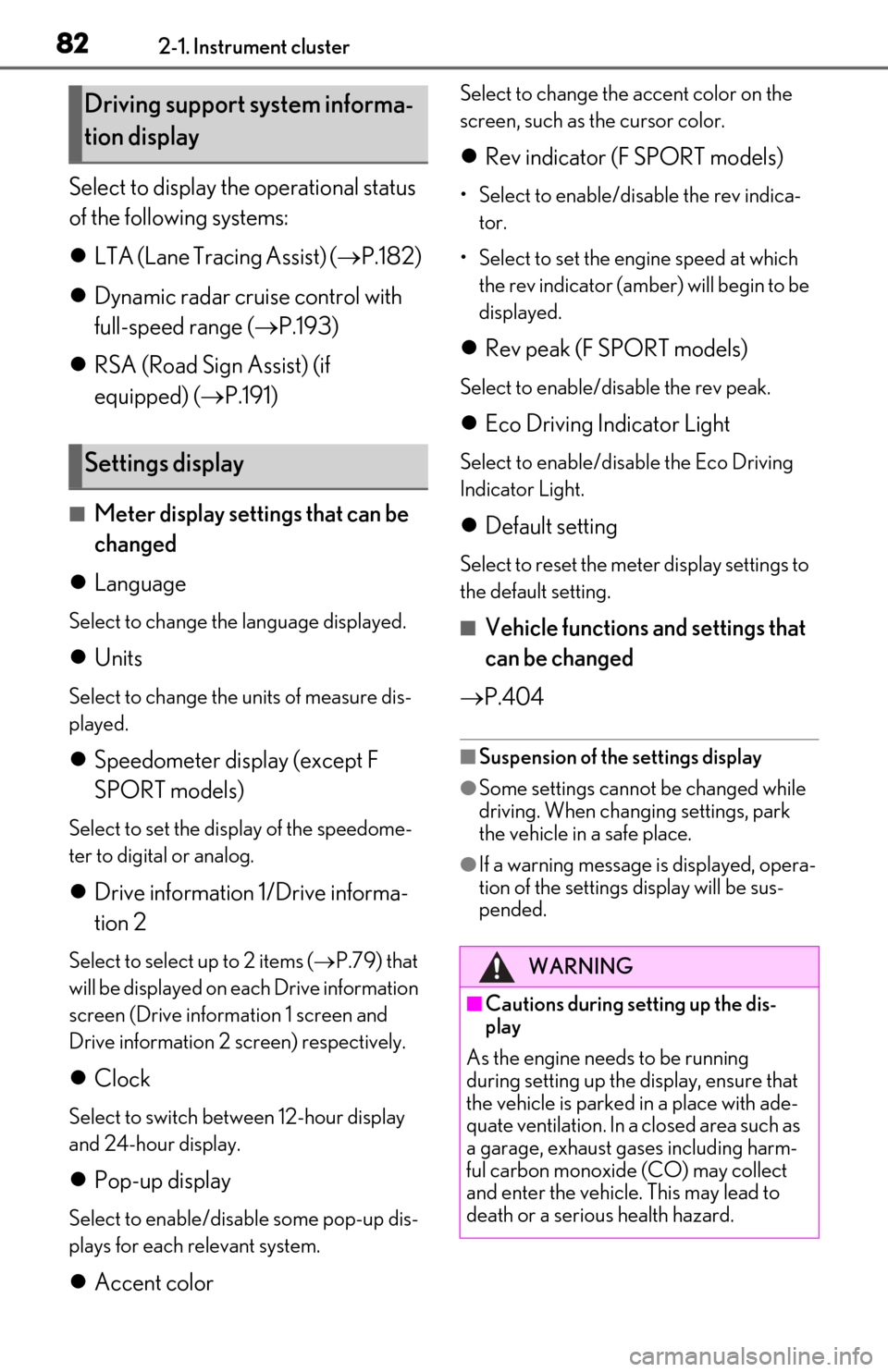
822-1. Instrument cluster
Select to display the operational status
of the following systems:
LTA (Lane Tracing Assist) ( P.182)
Dynamic radar cruise control with
full-speed range ( P.193)
RSA (Road Sign Assist) (if
equipped) ( P.191)
■Meter display settings that can be
changed
Language
Select to change th e language displayed.
Units
Select to change the units of measure dis-
played.
Speedometer display (except F
SPORT models)
Select to set the display of the speedome-
ter to digital or analog.
Drive information 1/Drive informa-
tion 2
Select to select up to 2 items ( P.79) that
will be displayed on ea ch Drive information
screen (Drive information 1 screen and
Drive information 2 screen) respectively.
Clock
Select to switch be tween 12-hour display
and 24-hour display.
Pop-up display
Select to enable/disable some pop-up dis-
plays for each relevant system.
Accent color
Select to change the accent color on the
screen, such as the cursor color.
Rev indicator (F SPORT models)
• Select to enable/disable the rev indica-
tor.
• Select to set the engine speed at which the rev indicator (amber) will begin to be
displayed.
Rev peak (F SPORT models)
Select to enable/disable the rev peak.
Eco Driving Indicator Light
Select to enable/disable the Eco Driving
Indicator Light.
Default setting
Select to reset the meter display settings to
the default setting.
■Vehicle functions and settings that
can be changed
P.404
■Suspension of the settings display
●Some settings cannot be changed while
driving. When changing settings, park
the vehicle in a safe place.
●If a warning message is displayed, opera-
tion of the settings display will be sus-
pended.
Driving support system informa-
tion display
Settings display
WARNING
■Cautions during setting up the dis-
play
As the engine needs to be running
during setting up the display, en sure that
the vehicle is parked in a place with ade-
quate ventilation. In a closed area such as
a garage, exhaust gases including harm-
ful carbon monoxide (CO) may collect
and enter the vehicle. This may lead to
death or a serious health hazard.
Page 88 of 450

862-1. Instrument cluster
items:
• Route guidance to destination/street
name
• Driving support system display
*
• Compass (heading-up display)
• Audio system operation status
*: Make sure to enable this display when using the driving support systems
Display angle
Select to adjust the angle of the head-up
display.
■Enabling/disabling of the head-up dis-
play
If the head-up display is disabled, it will
remain disabled when the engine switch is
turned off then back to IGNITION ON
mode.
■Display brightness
The brightness of the head-up display can
be adjusted on of the multi-information
display. Also, it is automatically adjusted
according to the ambient brightness.
■Head-up display automatic position
adjustment
If the display position is recorded into mem-
ory, the head-up display will be automati-
cally adjusted to the desired position.
( P.114)
■When the battery is disconnected
The customize settings of the head-up dis-
play will be reset.
Displays the operational status of the
following systems:
LTA (Lane Tracing Assist) ( P.182)
Dynamic radar cruise control with
full-speed range ( P.193)
Details of content displayed on the head-
up display may differ from that displayed
on the multi-inform ation display. For
details, refer to the explanation of each sys-
tem.
Pop-up displays for the following sys-
tems will be displayed when necessary.
■Driving support systems
Displays a warning/suggestion/advice
message or the operating state of a rel-
WARNING
■Caution for changing settings of the
head-up display
As the engine needs to be running while
changing the settings of the head-up dis-
play, ensure that the vehicle is parked in a
place with adequate ventilation. In a
closed area such as a garage, exhaust
gases including harmful carbon monox-
ide (CO) may collect and enter the vehi-
cle. This may lead to death or a serious
health hazard.
NOTICE
■When changing the settings of the
head-up display
To prevent battery discharge, ensure that
the engine is running while the changing
the settings of the head-up display.
Driving support system display
area
Pop-up display
Page 89 of 450
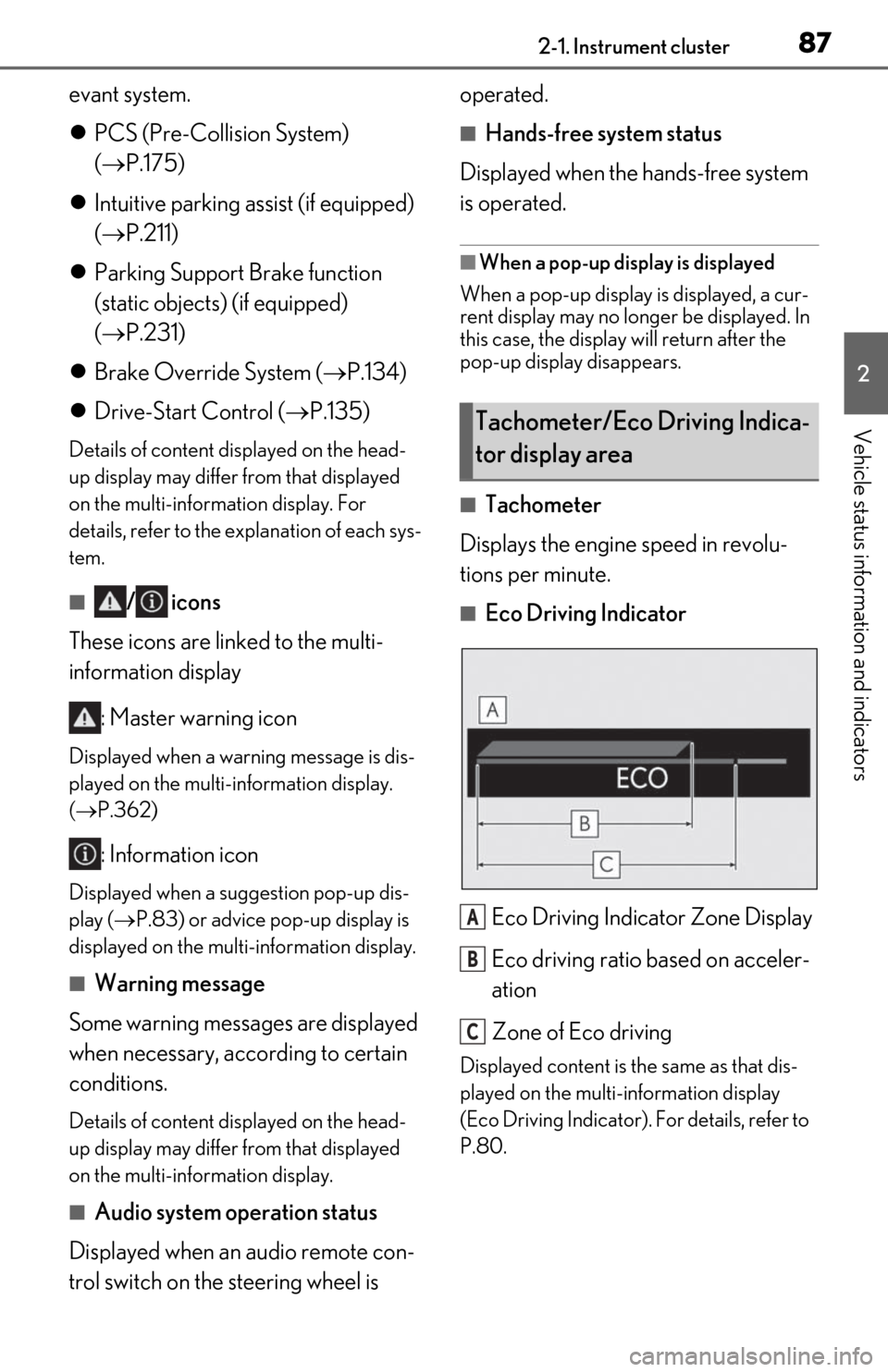
872-1. Instrument cluster
2
Vehicle status information and indicators
evant system.
PCS (Pre-Collision System)
( P.175)
Intuitive parking assist (if equipped)
( P.211)
Parking Support Brake function
(static objects) (if equipped)
( P.231)
Brake Override System ( P.134)
Drive-Start Control ( P.135)
Details of content di splayed on the head-
up display may differ from that displayed
on the multi-information display. For
details, refer to the explanation of each sys-
tem.
■/ icons
These icons are linked to the multi-
information display
: Master warning icon
Displayed when a warning message is dis-
played on the multi-information display.
( P.362)
: Information icon
Displayed when a suggestion pop-up dis-
play ( P.83) or advice pop-up display is
displayed on the multi-information display.
■Warning message
Some warning messages are displayed
when necessary, according to certain
conditions.
Details of content di splayed on the head-
up display may differ from that displayed
on the multi-information display.
■Audio system operation status
Displayed when an audio remote con-
trol switch on the steering wheel is operated.
■Hands-free system status
Displayed when the hands-free system
is operated.
■When a pop-up display is displayed
When a pop-up display is displayed, a cur-
rent display may no long er be displayed. In
this case, the display will return after the
pop-up display disappears.
■Tachometer
Displays the engine speed in revolu-
tions per minute.
■Eco Driving Indicator
Eco Driving Indicator Zone Display
Eco driving ratio based on acceler-
ation
Zone of Eco driving
Displayed content is th e same as that dis-
played on the multi-information display
(Eco Driving Indicator). For details, refer to
P.80.
Tachometer/Eco Driving Indica-
tor display area
A
B
C
Page 110 of 450

1083-2. Opening, closing and locking the doors and trunk
situations, the communication between the
electronic key and the vehicle may be
affected, preventing the smart access sys-
tem with push-button start, wireless remote
control and engine immobilizer system
from operating properly.
(Ways of coping: P.376)
●When the electronic key battery is
depleted
●Near a TV tower, electric power plant,
gas station, radio stat ion, large display,
airport or other faci lity that generates
strong radio waves or electrical noise
●When the electronic key is in contact
with, or is covered by the following metal-
lic objects
• Cards to which aluminum foil is attached
• Cigarette boxes that have aluminum foil
inside
• Metallic wallets or bags
•Coins
• Hand warmers made of metal
• Media such as CDs and DVDs
●When other wireless ke ys (that emit radio
waves) are being used nearby
●When carrying the electronic key
together with the following devices that
emit radio waves
• Portable radio, cellular phone, cordless phone or other wireless communication
device
• Another electronic ke y or a wireless key
that emits radio waves
• Personal computers or personal digital assistants (PDAs)
• Digital audio players
• Portable game systems
●If window tint with a metallic content or
metallic objects are attached to the rear
window
●When the electronic key is placed near a
battery charger or electronic devices
●When the vehicle is parked in a pay park-
ing spot where radio waves are emitted.
■Notes for the entry function
●Even when the electronic key is within the
effective range (detection areas), the sys-
tem may not operate properly in the fol-
lowing cases:
• The electronic key is too close to the win- dow or outside door handle, near the
ground, or in a high place when the doors
are locked or unlocked.
• The electronic key is near the ground or
in a high place, or too close to the center
of the rear bumper when the trunk is
opened.
• The electronic key is on the instrument panel, rear package tray or floor, or in the
door pockets or glove box when the
engine is started or engine switch modes
are changed.
●Do not leave the electronic key on top of
the instrument panel or near the door
pockets when exiting the vehicle.
Depending on the radio wave reception
conditions, it may be detected by the
antenna outside the cabin and the doors
will become lockable from the outside,
possibly trapping the electronic key
inside the vehicle.
●As long as the electronic key is within the
effective range, the doors may be locked
or unlocked by anyone. However, only
the doors detecting the electronic key
can be used to unlock the vehicle.
●Even if the electronic key is not inside the
vehicle, it may be po ssible to start the
engine if the electronic key is near the
window.
●The doors may unlock or lock if a large
amount of water splashes on the door
handle, such as in the rain or in a car
wash, when the electronic key is within
the effective range. (The doors will auto-
matically be locked after approximately
60 seconds if the doors are not opened
and closed.)
●If the wireless remote control is used to
lock the doors when the electronic key is
near the vehicle, there is a possibility that
the door may not be unlocked by the
entry function. (Use the wireless remote
control to unlock the doors.)
●Touching the door lock sensor while
wearing gloves may delay or prevent lock
operation. Remove the gloves and touch
the lock sensor again.
●When the lock operation is performed
using the lock sensor, recognition signals
will be shown up to two consecutive
Page 135 of 450

133
4
4
Driving
Driving
4-1. Before drivingDriving the vehicle ..................... 134
Cargo and luggage ................... 139
Vehicle load limits ....................... 141
Trailer towing ................................ 141
Dinghy towing ............................. 142
4-2. Driving procedures Engine (ignition) switch ........... 143
Automatic transmission........... 147
Turn signal lever........................... 151
Parking brake .............................. 152
Brake Hold.................................... 154
4-3. Operating the lights and wipers Headlight switch ......................... 156
Automatic High Beam ............. 159
Windshield wipers and washer .......................................................... 161
4-4. Refueling Opening the fuel tank cap...... 167
4-5. Using the driving support sys- tems
Lexus Safety System + 2.0 ..... 169
PCS (Pre-Collision System).. 175
LTA (Lane Tracing Assist)...... 182
RSA (Road Sign Assist) ............ 191
Dynamic radar cruise control with full-speed range....................... 193
BSM (Blind Spot Monitor) .... 203
Driving Mode Select switch . 208PKSA (Parking Support Alert)
........................................................ 210
Intuitive parking assist ................ 211
RCTA (Rear cross traffic alert) function........................................ 218
RCD (Rear Camera Detection) function........................................ 222
PKSB (Parking Support Brake) ....................................................... 225
Parking Support Brake function (static objects) .......................... 231
Parking Support Brake function (rear-crossing vehicles) ...... 237
Parking Support Brake function (rear pedestrians) .................... 241
Driving assist systems.............. 244
4-6. Driving tips Winter driving tips .................... 248
Page 136 of 450
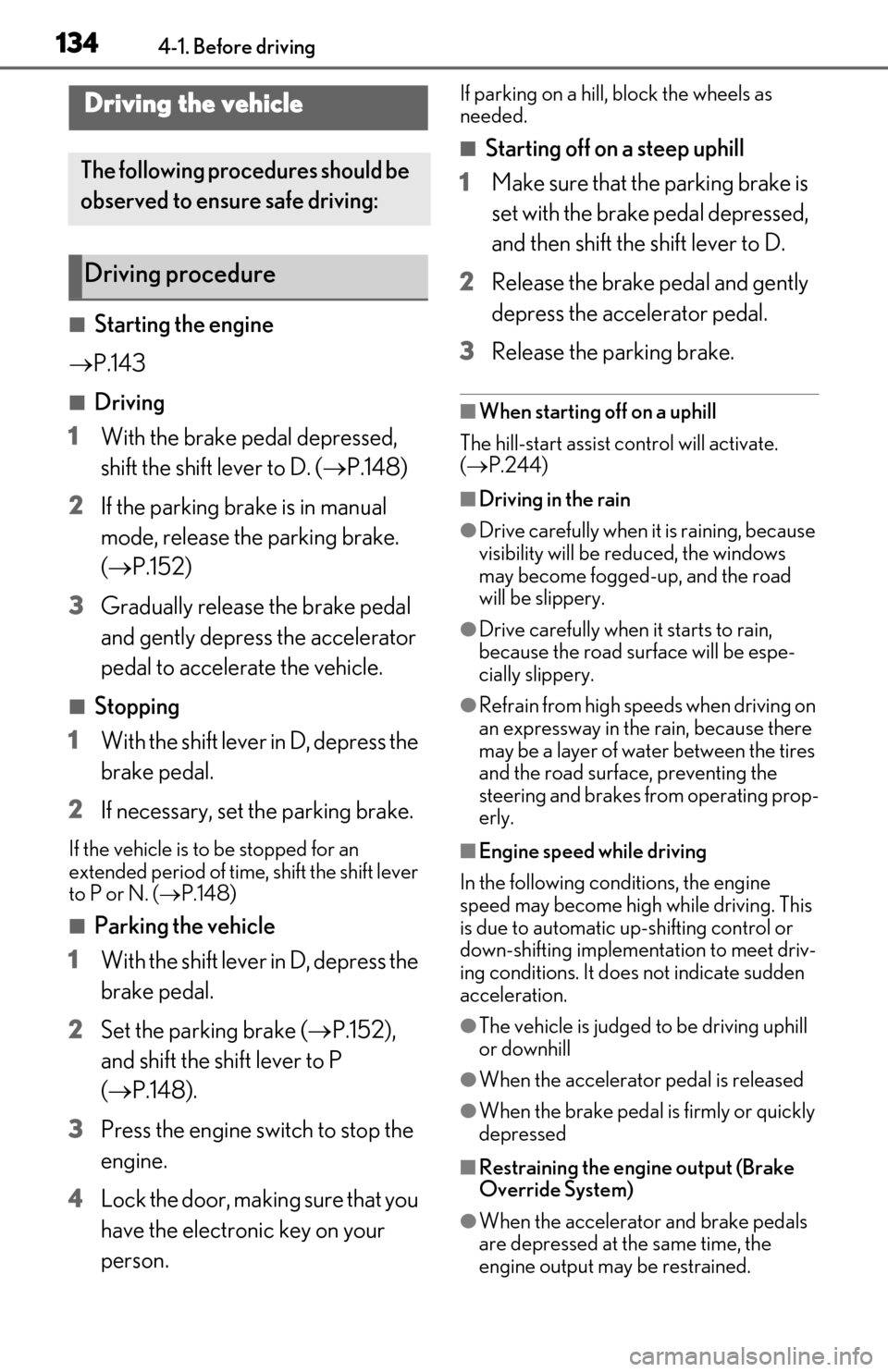
1344-1. Before driving
4-1.Before driving
■Starting the engine
P.143
■Driving
1 With the brake pedal depressed,
shift the shift lever to D. ( P.148)
2 If the parking brake is in manual
mode, release the parking brake.
(P.152)
3 Gradually release the brake pedal
and gently depress the accelerator
pedal to accelerate the vehicle.
■Stopping
1 With the shift lever in D, depress the
brake pedal.
2 If necessary, set the parking brake.
If the vehicle is to be stopped for an
extended period of time, shift the shift lever
to P or N. ( P.148)
■Parking the vehicle
1 With the shift lever in D, depress the
brake pedal.
2 Set the parking brake ( P.152),
and shift the shift lever to P
( P.148).
3 Press the engine switch to stop the
engine.
4 Lock the door, making sure that you
have the electronic key on your
person.
If parking on a hill, block the wheels as
needed.
■Starting off on a steep uphill
1 Make sure that the parking brake is
set with the brake pedal depressed,
and then shift the shift lever to D.
2 Release the brake pedal and gently
depress the accelerator pedal.
3 Release the parking brake.
■When starting off on a uphill
The hill-start assist control will activate.
( P.244)
■Driving in the rain
●Drive carefully when it is raining, because
visibility will be reduced, the windows
may become fogged-up, and the road
will be slippery.
●Drive carefully when it starts to rain,
because the road surface will be espe-
cially slippery.
●Refrain from high speeds when driving on
an expressway in the rain, because there
may be a layer of wa ter between the tires
and the road surface, preventing the
steering and brakes from operating prop-
erly.
■Engine speed while driving
In the following conditions, the engine
speed may become high while driving. This
is due to automatic up-shifting control or
down-shifting implementation to meet driv-
ing conditions. It does not indicate sudden
acceleration.
●The vehicle is judged to be driving uphill
or downhill
●When the accelerato r pedal is released
●When the brake pedal is firmly or quickly
depressed
■Restraining the engine output (Brake
Override System)
●When the accelerator and brake pedals
are depressed at the same time, the
engine output may be restrained.
Driving the vehicle
The following procedures should be
observed to ensure safe driving:
Driving procedure
Page 140 of 450

1384-1. Before driving
WARNING
●If the brake booster device does not
operate, do not follow other vehicles
closely and avoid hills or sharp turns
that require braking.
In this case, braking is still possible, but
the brake pedal should be depressed
more firmly than usual. Also, the brak-
ing distance will increase. Have your
brakes fixed immediately.
●Do not pump the brake pedal if the
engine stalls.
Each push on the brake pedal uses up
the reserve for the power-assisted
brakes.
●The brake system consists of 2 or more
individual hydraulic systems; if one of
the systems fails, the other(s) will still
operate. In this case, the brake pedal
should be depressed more firmly than
usual and the braking distance will
increase. Have your brakes fixed
immediately.NOTICE
■When driving the vehicle
●Do not depress the accelerator and
brake pedals at the same time while
driving, as this may restrain the engine
output.
●Do not use the accelerator pedal or
depress the accelerator and brake
pedals at the same time to hold the
vehicle on a hill.
■Avoiding damage to vehicle parts
●Do not turn the steering wheel fully in
either direction and hold it there for an
extended period of time.
Doing so may damage the power
steering motor.
●When driving over bumps in the road,
drive as slowly as possible to avoid
damaging the wheels, underside of the
vehicle, etc.
■If you get a flat tire while driving
A flat or damaged tire may cause the fol-
lowing situations. Hold the steering
wheel firmly and gradually depress the
brake pedal to slow down the vehicle.
●It may be difficult to control your vehi-
cle.
●The vehicle will make abnormal
sounds or vibrations.
●The vehicle will lean abnormally.
Information on what to do in case of a flat
tire ( P.366)
■When encountering flooded roads
Do not drive on a road that has flooded
after heavy rain etc. Doing so may cause
the following serious damage to the vehi-
cle:
●Engine stalling
●Short in electrical components
●Engine damage caused by water
immersion
In the event that you drive on a flooded
road and the vehicle is flooded, be sure
to have your Lexus dealer check the fol-
lowing:
●Brake function
●Changes in quantity and quality of oil
and fluid used for the engine, auto-
matic transmission, etc.
●Lubricant condition for the bearings
and suspension joints (where possi-
ble), and the function of all joints, bear-
ings, etc.
■When parking the vehicle
Always set the parking brake, and shift
the shift lever to P. Failure to do so may
cause the vehicle to move or the vehicle
may accelerate suddenly if the accelera-
tor pedal is accidentally depressed.